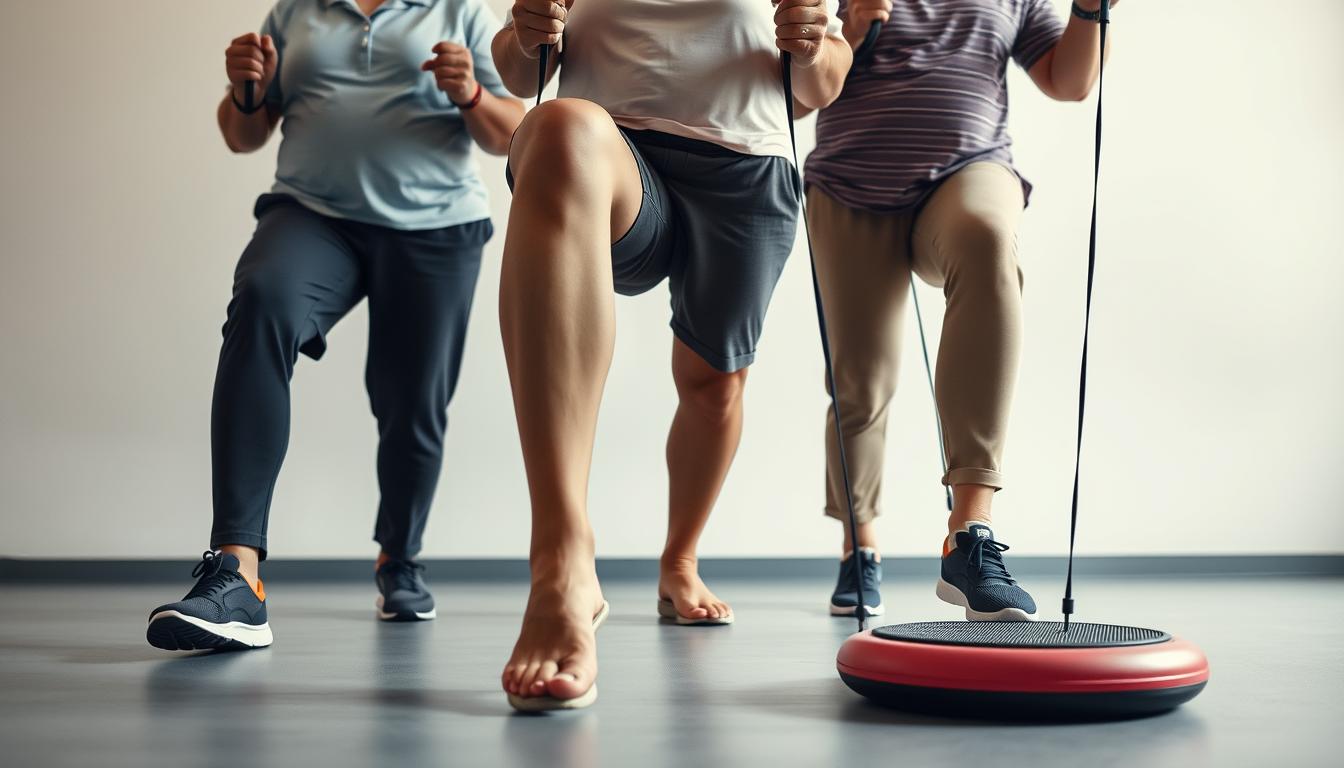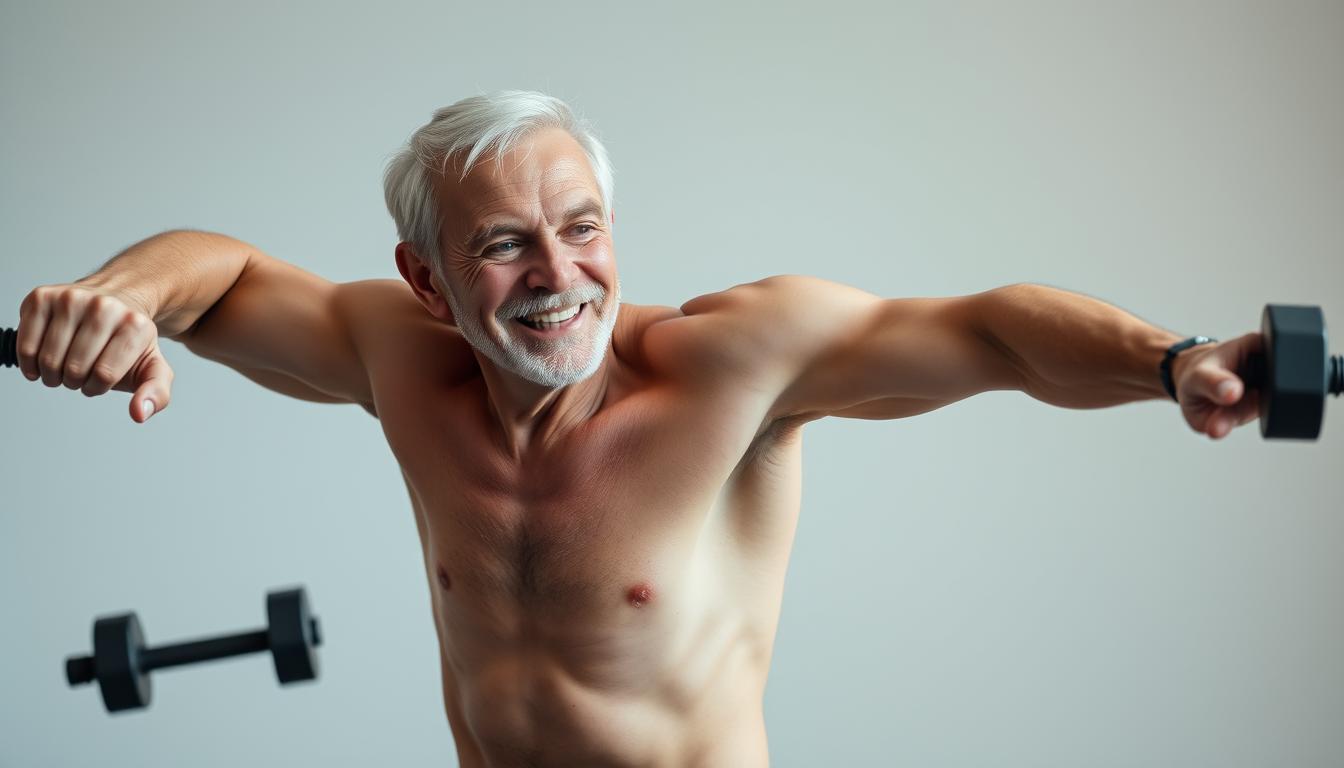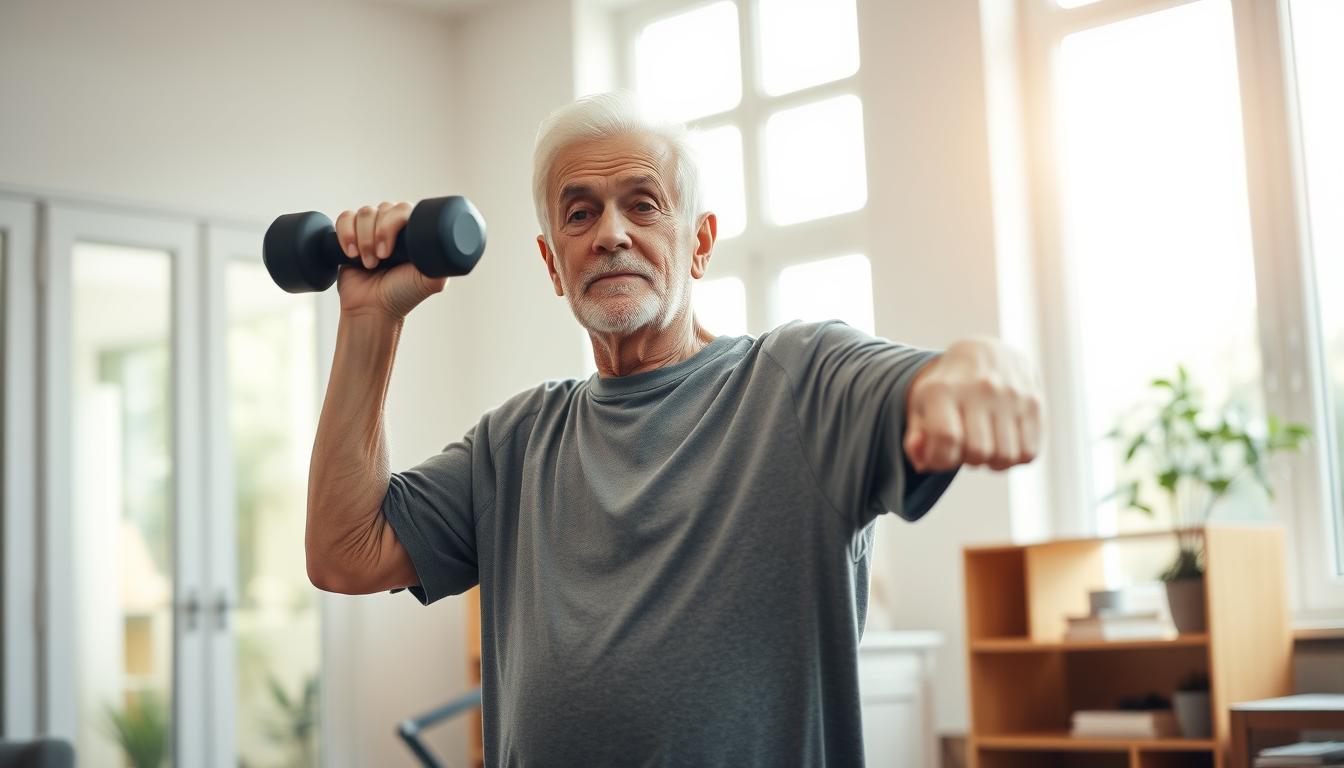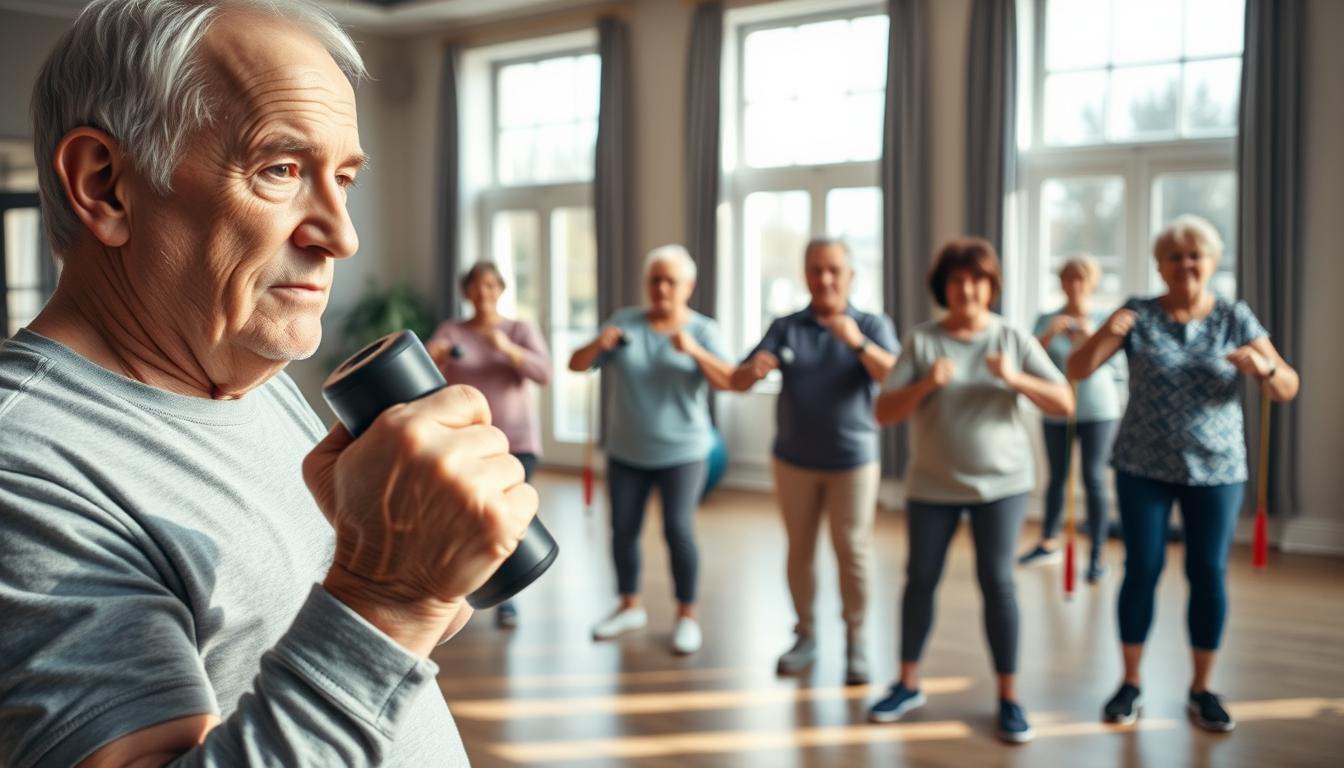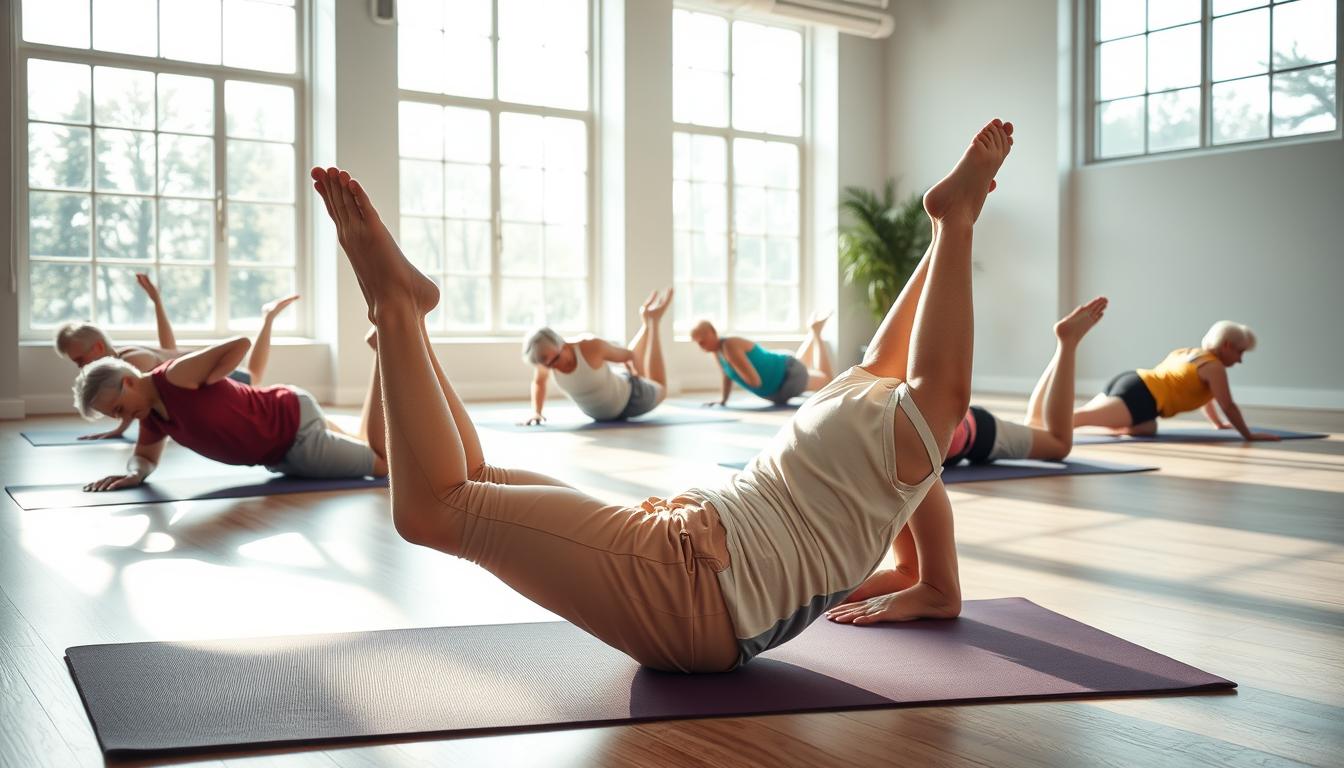Want to keep carrying groceries, chasing grandkids, and actually enjoying that morning walk? The secret’s simpler than you think: stronger lower-body muscles. As Dr. Vanessa Matos from Hinge Health puts it, “Your legs are your mobility headquarters—neglect them, and daily life gets way harder than it needs to be.”
Let’s get real for a second. That awkward shuffle when you stand up from the couch? The white-knuckle grip on the stair railing? Been there. But here’s the kicker: research shows even basic moves like sit-to-stand drills can slash fall risks by 30%. No fancy gym gear required—just your living room and a sturdy chair.
I’ll never forget my client Martha, 72, who joked that her “grocery cart ballet” (leaning on the cart for balance) became unnecessary after six weeks of targeted workouts. Her newfound confidence? Priceless. We’re talking about reclaiming independence here, not training for the Olympics.
Physical therapists agree: consistency beats intensity. Whether it’s stabilizing your hips for uneven sidewalks or building endurance for gardening marathons, these routines are your ticket to staying fiercely self-sufficient. Ready to outsmart gravity? Let’s dive into the moves that actually matter.
Understanding the Essentials of Leg Strength

Mobility isn’t just about moving—it’s about living life on your terms. Your lower-body muscles are your personal support system, quietly powering everything from bending down to pet the dog to reaching that top shelf without wobbling. Let’s unpack why this matters more than you might think.
Why Mobility Matters for Daily Life
Ever notice how some days feel like a marathon? Grocery runs, neighborhood walks, even standing while brushing your teeth—they all demand resilience. Research from Hinge Health reveals that improved lower-body function directly translates to easier transitions between sitting and standing. Think about climbing stairs without death-gripping the rail or chasing after a runaway trash can in the wind. That’s the game-changer.
Concrete Examples from Physical Therapy Advice
Physical therapists swear by simple moves with big payoffs. Take calf raises: this sneaky-good move builds ankle stability, making icy sidewalks less terrifying. One client told me, “I finally stopped doing the ‘old lady shuffle’ after adding these to my routine.”
Another pro tip? Focus on control over speed. Whether it’s slowly lowering into a chair or pausing mid-step, intentional movements rewire your balance systems. As one specialist put it, “Strong legs aren’t just muscles—they’re your built-in shock absorbers.”
Bottom line: Your independence hinges on these basics. And trust me, your future self will thank you for every rep.
How Strong Legs Impact Daily Activities
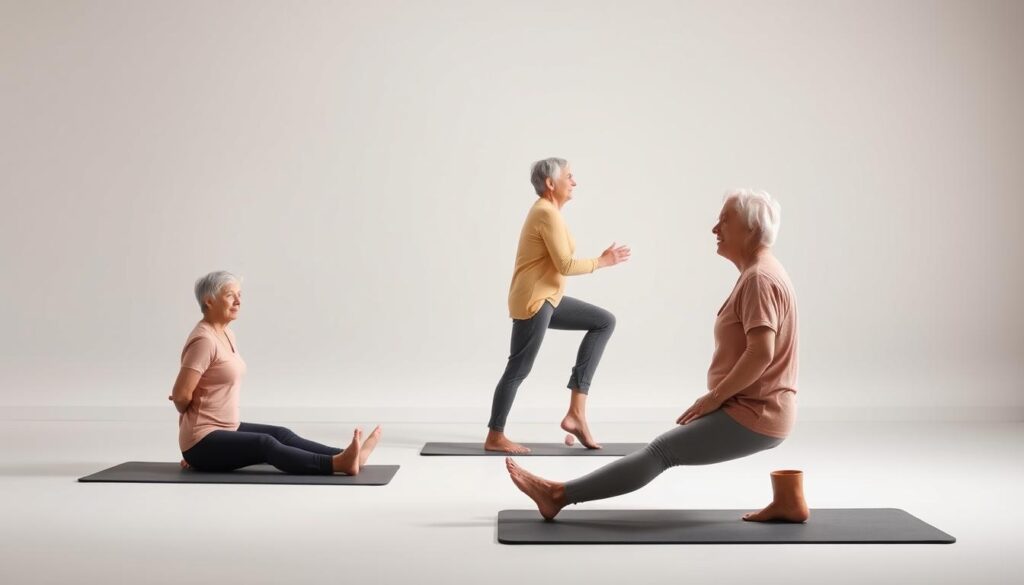
Ever step off a curb and feel that split-second wobble? That’s your body’s built-in GPS recalibrating—but stronger muscles mean faster corrections. Think of your thighs and calves as living guardrails, keeping you upright when life throws uneven pavement or slippery floors your way.
Balance Boosters You’ll Actually Use
Here’s the deal: sit-to-stand drills aren’t just chair acrobatics. They teach your hips and knees to work as a team. Try this: Scoot forward, lean your chest toward your knees (yes, like you’re about to spill the tea), then push through your heels. Bam—you’re standing! Reverse it slowly. Three secrets? Keep feet flat, don’t use armrests, and exhale as you rise.
| Step | Key Focus | Pro Tip |
|---|---|---|
| 1. Sit edge of chair | Feet hip-width | Pretend you’re balancing a book on your head |
| 2. Lean forward | Nose over toes | Say “hup!” as you push up—it engages core muscles |
| 3. Lower slowly | Control descent | Count “3-Mississippi” on the way down |
Now let’s talk knee extensions. Sitting tall? Perfect. Straighten one leg until your toes point at the ceiling. Hold for two breaths. This sneaky-good move builds stability for those “oh crap” moments when you catch yourself mid-stumble.
One-leg stands are your secret weapon. Brush your teeth while balancing on your right foot. Switch sides when you spit. Sounds silly? My client Edna, 68, swears this helped her navigate her daughter’s cobblestone driveway without white-knuckling her son-in-law’s arm.
Remember: Consistency trumps perfection. Five minutes daily beats marathon sessions. Your future self will high-five you every time you breeze through a crowded aisle or dodge a rogue skateboard.
Integrating Exercises into Your Routine
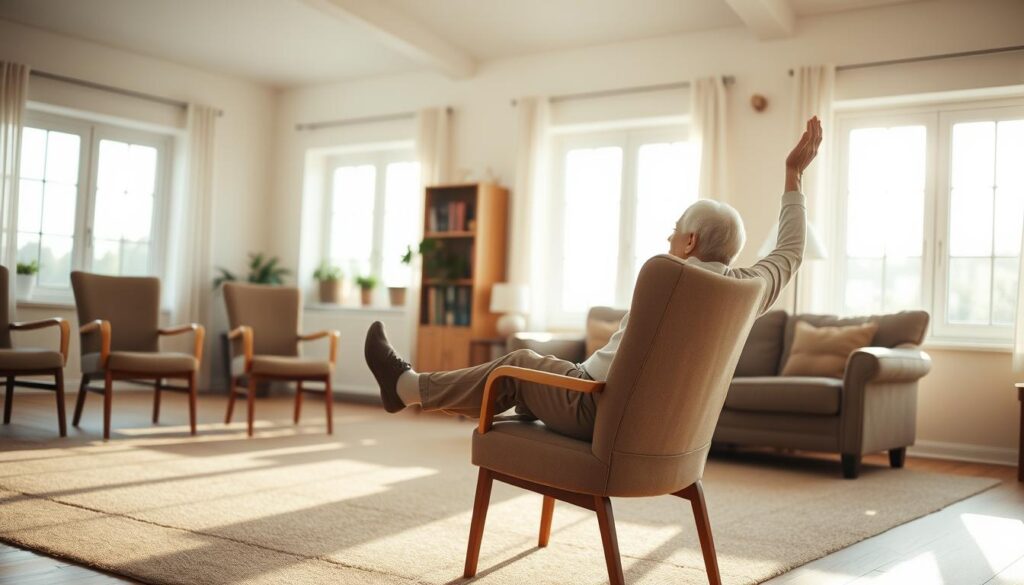
Let’s talk about turning your living room into a mobility lab—no white coat required. The trick? Blending movement with your daily rhythm so it feels less like “working out” and more like living better. Trust me, your favorite recliner just became gym equipment.
Simple Chair and Floor-Based Workouts
Start with the coffee-maker shuffle. While waiting for your brew, try this:
- Sit back halfway to the chair (like you’re testing for a hot seat)
- Keep heels floor-glued as you lower
- Pause when thighs parallel to ground—no need to fully sit
Boom—you’ve just done a chair-assisted squat. Do three reps while your mug fills. Pro tip: Imagine you’re holding a beach ball between your knees to engage those muscles front and center.
| Activity | Exercise Hack | Why It Works |
|---|---|---|
| TV time | Commercial break leg lifts | Builds hip stability during downtime |
| Phone calls | Wall sits while chatting | Strengthens quads passively |
| Microwave use | Calf raises as food heats | Improves ankle mobility |
Cueing Your Body with Step-by-Step Actions
Here’s where magic happens: Break movements into mental checklists. When rising from a seat:
- “Nose over toes” (lean forward)
- “Heels plant like tree roots”
- “Push through floor” (stand)
This three-part cue prevents that awful lurching motion. One client calls it her “stand-up haiku.”
Remember: Your chair is both tool and teacher. When lowering, sit back like you’re reaching for a hammock behind you—forces proper hip hinge. And always? Keep those heels floor-bound. My rule: If your toes could wave hello mid-move, you’re leaning too far forward.
Consistency tip: Pair exercises with daily anchors. Do knee extensions while the tea steeps. Balance on one leg during toothpaste cap removal. Before you know it, strength-building becomes as routine as your morning crossword.
Leg Strength Exercises for Seniors: Your Practical Guide
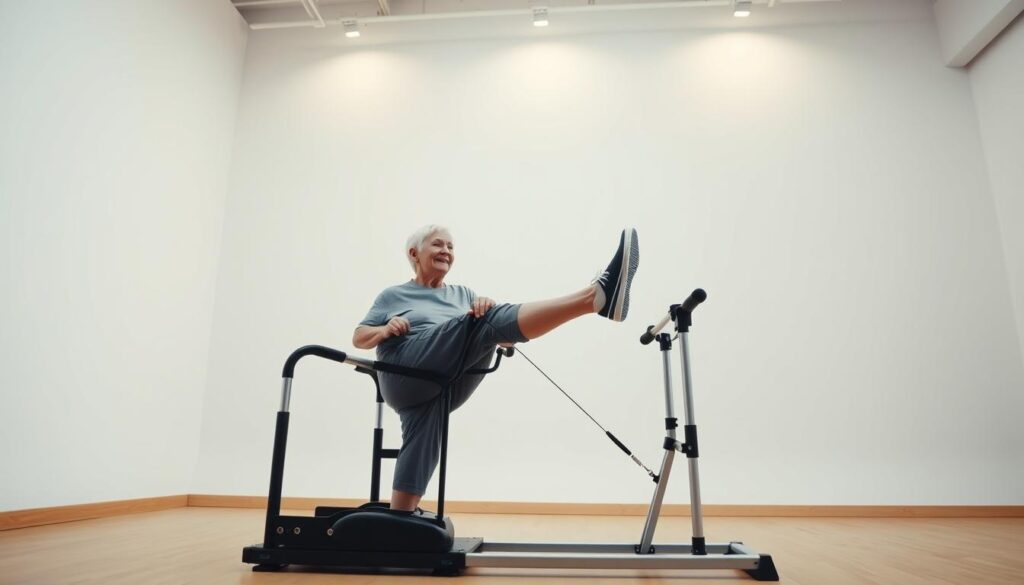
Here’s the truth: small tweaks to daily moves can prevent big stumbles later. Whether you’re recovering from surgery or just want to feel steadier, smart modifications make all the difference. Let’s break down the moves that build confidence—not frustration.
Key Movements and Modifications
Take knee extensions. Sitting tall works, but try this progression: Start seated, straighten one leg, then add a 2-second hold. Too easy? Do it standing while gripping a counter. Physical therapist Linda Torres notes, “This dual approach builds stability whether you’re rising from a car seat or catching yourself mid-trip.”
Why adjust? Your joints aren’t cookie-cutter. If bending deeply hurts, shorten the range. One client told me, “Doing half-squats let me finally play with my granddog without knee fireworks.”
| Movement | Beginner Version | Next-Level Hack |
|---|---|---|
| Stand back drills | Use armrests for support | Cross arms over chest |
| Step-ups | 2-inch curb height | Add marching motion |
| Side leg lifts | Seated with pillow support | Standing near wall |
Here’s the scoop: Control beats speed. When lowering into a chair, count “one-potato-two” to engage muscles properly. I’ve seen folks transform their stability just by slowing down—no fancy gear required.
Pro tip: Pair moves with daily tasks. Do seated marches while microwaving leftovers. Practice standing on one leg during toothpaste cap twists. Your body learns best in bite-sized chunks.
Remember: Progress isn’t linear. Some days feel like dancing; others like wobbly Jell-O. That’s normal. As Torres says, “Safety first, ego last.” Your future grocery-carrying self will thank you.
Mastering Seated and Modified Movements
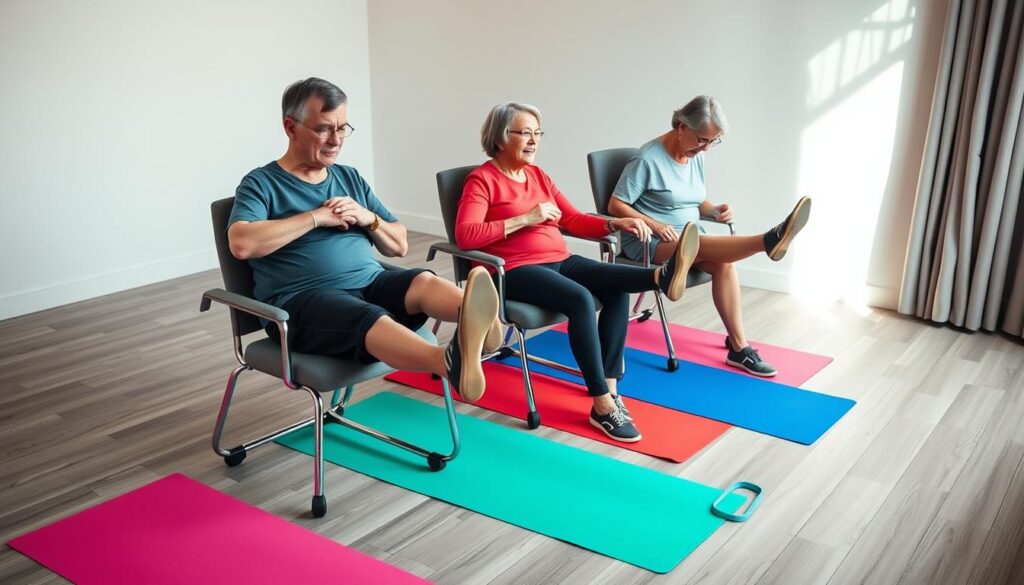
Your favorite armchair just became a powerhouse. Hinge Health’s research shows that strategic seated movements build stability for real-world tasks—like hoisting yourself out of deep couches or reaching for that rogue sock under the bed. Let’s unlock the magic of modified workouts that meet you where you’re seated.
Sit-to-Stand Exercise Details
This move isn’t just about standing—it’s about retraining your body’s launch sequence. Here’s the blueprint:
- Scoot forward until your knees form a right angle
- Press palms against thighs as you lean nose-over-toes
- Push through heels like you’re squishing grapes
My client Roy, 79, calls this his “rocket launch” move. “Now I pop up from stadium seats without embarrassing grunts,” he laughs. Pro tip: Place a pillow behind you if lowering feels shaky—it’s like training wheels for your hips.
| Common Mistake | Fix | Why It Works |
|---|---|---|
| Using armrests | Cross arms over chest | Forces legs to engage |
| Rushing upward | Count “up-2-3” aloud | Builds control |
| Feet too close | Spread knees apple-width | Improves balance |
Seated Knee Extensions for Improved Strength
Think of these as stealth quad builders. Sitting tall? Perfect. Straighten one leg until your kneecap winks at the ceiling. Hold for three slow breaths. Too easy? Add ankle weights or pretend you’re pushing through molasses.
Physical therapist Lena Cruz advises: “Imagine your thighbone lengthening—like you’re stretching taffy from hip to knee.” This mental cue prevents that awful knee crunch feeling. One client reported she could finally lift her 15-pound terrier into the car after mastering these.
Remember: Your chair is your ally. Whether it’s kitchen stool squats or balcony knee lifts, consistency turns furniture into fitness gear. Now go show that recliner who’s boss.
Calf Raises and Hip Workouts for Steady Support
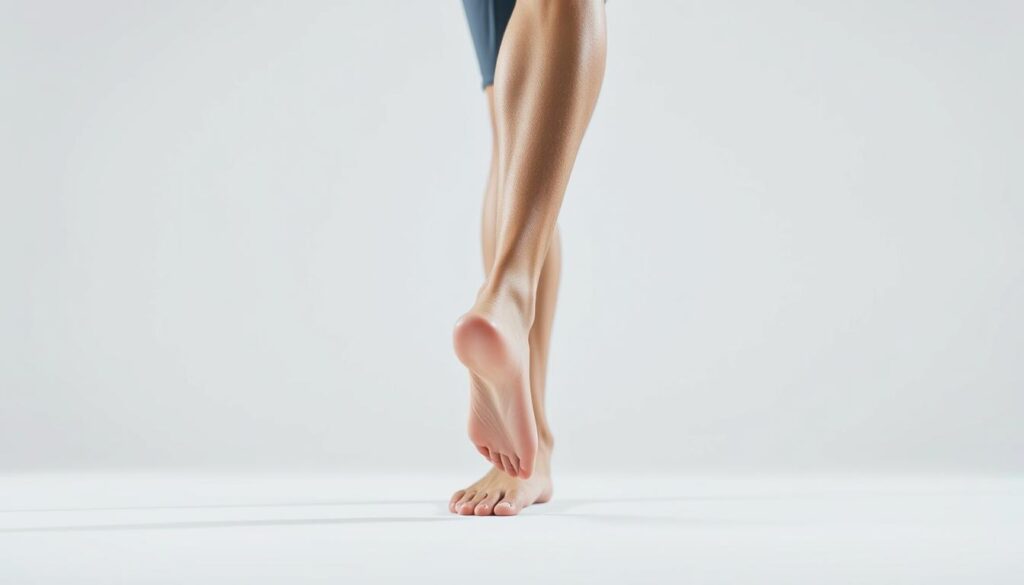
Ever felt that heart-flutter moment when stepping onto an uneven curb? Meet your new secret weapon: calf raises. These unsung heroes of daily stability do more than you’d guess—research shows strong lower legs can reduce trip risks by 42% in adults over 60. And the best part? You’re probably already doing them without realizing it.
Breaking Down Calf Raises
Here’s the magic formula: Stand near a counter (safety first!), feet hip-width. Press through your toes like you’re squishing grapes, then lower slowly. Physical therapist Dr. Marco Perez calls this “the elevator move”—imagine your heels riding down floor by floor.
Why bother? Strong calves act like built-in shock absorbers. My client Rita, 71, noticed she could finally:
- Carry laundry upstairs without pausing on each step
- Navigate her granddaughter’s cobblestone driveway confidently
- Reach high shelves without that telltale wobble
| Common Mistake | Quick Fix | Why It Matters |
|---|---|---|
| Bouncing at the top | Pause for 1 breath | Builds endurance over momentum |
| Knees buckling inward | Imagine hugging a beach ball | Protects joints during push-off |
| Rushing the descent | Count “3-Mississippi” down | Strengthens braking muscles |
Pro tip: Turn mundane moments into mini-workouts. Do calf raises while microwaving leftovers or brushing teeth. As Perez says, “Consistency creates competence—your feet will thank you during leaf-raking season.”
Advanced Moves for Balanced Strength: Squats and Lunges
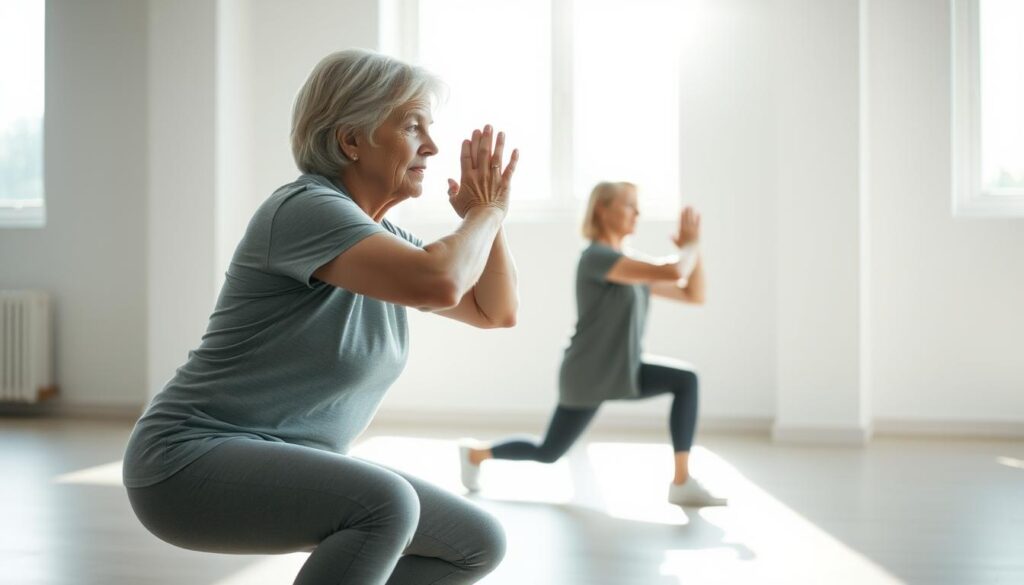
Time to level up your stability game. Squats and lunges aren’t just gym-bro territory—they’re your ticket to rock-solid confidence on uneven terrain. Here’s the scoop: these moves train your entire lower body to work as a team, whether you’re navigating airport terminals or chasing sunset views.
Standard vs. Partial Squats: Choose Your Adventure
Full-range squats get all the glory, but partials are the unsung heroes for those with cranky knees. Hinge Health data shows that reducing depth by 30% cuts joint stress while still building crucial thigh muscles. Try this:
- Stand facing a sturdy chair, feet apple-width apart
- Lower until thighs parallel to seat (about 45 degrees)
- Pause—pretend you’re hovering over a public toilet seat
- Push through heels to rise
| Move | Depth | Best For | Pro Tip |
|---|---|---|---|
| Standard | Full range | Advanced folks | Keep weight in heels |
| Partial | Half range | Knee concerns | Use chair as guide |
Reverse Lunges: Your Balance Sidekick
Traditional lunges can feel like a trust fall with gravity. Reverse versions? Way friendlier. Step back instead of forward—it’s easier on joints and builds single-leg stability for stairs and curbs. My client Marge, 74, calls these her “slow-mo ninja moves.”
Try this hack:
- Hold countertop for support
- Step back 12 inches, tap toe
- Return slowly—count “2-Mississippi”
Struggling? No shame. Physical therapists recommend chair-assisted lunges: sit halfway, shift weight to one side, then stand. It’s like training wheels for your hips. Remember: Progress beats perfection. Your grocery bags won’t care if you started with partial reps—they’ll just feel lighter.
Building Resilience with Chair Deadlifts and Related Moves
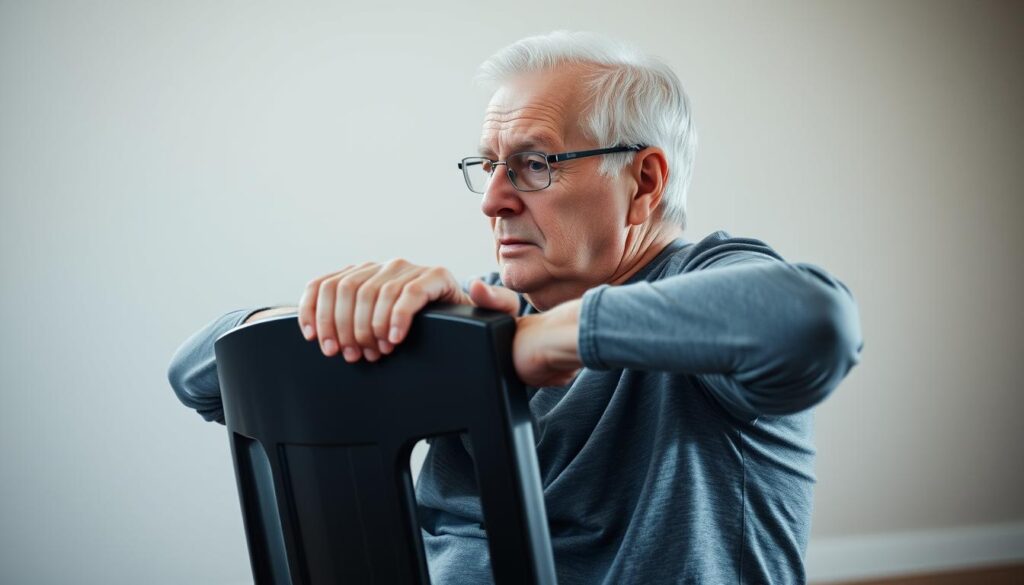
Ever struggled to grab that runaway pill bottle from under the couch? Meet your new secret weapon: the chair deadlift. This move isn’t about brute force—it’s about teaching your hips and knees to work smarter. Think of it as your body’s natural crowbar for daily tasks.
When to Add Resistance Bands
Start with the basics: Stand facing a sturdy chair, feet planted like you’re growing roots. Hinge at the hips (imagine closing a car door with your rear end) while keeping your chest proud. Grab the seat, then push through your heels to rise. My client Jean, 69, calls this her “grocery bag resurrection move.”
Ready to level up? Loop a resistance band under your feet and hold the ends. Now that upward push works double-time. Physical therapist Luis Gomez advises: “Add bands only when you can do 12 reps without grunting—your knees will thank you later.”
| Common Mistake | Quick Fix | Why It Works |
|---|---|---|
| Rounding shoulders | Pretend you’re holding a beach ball | Protects spine alignment |
| Locking joints | Keep slight bend in knees | Reduces pressure on floor impact |
| Rushing the move | Count “up-2-3” aloud | Builds control for uneven surfaces |
Here’s the magic: Proper hip alignment makes everything easier—from tying shoes to wrestling with garden hoses. One client reported he could finally lift his 20-pound cat carrier after mastering this move. Remember: Your chair isn’t just furniture—it’s your partner in crime against gravity.
Smart Strategies for Progressing Your Workouts

Think of your workout progress like tending a garden—small, consistent care yields surprising growth. The key? Strategic nudges that challenge your body without crossing into “why did I do this to myself?” territory. Let’s explore how to level up smarter than a chess grandmaster.
Here’s my golden rule: Progress when it feels boringly easy. If you can chat through 15 calf raises while waiting for toast, it’s time to:
- Add 2 reps per session
- Hold a soup can during knee extensions
- Balance on a folded towel during foot drills
Physical therapists call this the “5% challenge”—tiny tweaks that sneak up on your muscles. One client joked it’s like her grandkid’s growth chart: “You don’t notice daily changes until suddenly, pants are too short!”
| Progress Hack | How-To | Real-World Benefit |
|---|---|---|
| Tempo shifts | Count “up-2-down-3” | Builds control for icy sidewalks |
| Foot positioning | Turn toes slightly out | Engages hidden hip muscles |
| Uneven surfaces | Stand on couch cushion | Trains ankles for grass/gravel |
Spotting plateaus is crucial. Can’t feel your toes gripping during balance drills? Time to ditch the countertop assist. Mastered seated marches? Try lifting knees higher—like you’re stepping over tiny fire hydrants.
Remember: Your strengthening journey isn’t linear. Some days feel like waltzing; others like herding cats. That’s normal! As my yoga-teacher neighbor says, “Progress hides in the messiest attempts.” Your future park-walking self will high-five you for every micro-adjustment.
Targeting Knee and Hip Sessions to Reduce Pain

Your knees and hips aren’t just hinges—they’re the gatekeepers of pain-free movement. Think about that creaky step you avoid or the way you shift weight when standing. Smart exercises can turn those “ouch” moments into “ahhh” breakthroughs. Let’s break down two moves that physical therapists swear by.
Flexions vs Extensions: What’s the Deal?
Knee flexions (bending) target the back of your thighs. Try this seated: Slide your heel toward your chair like you’re wiping mud off your shoe. Hold for two breaths. It’s like giving your hamstrings a gentle handshake.
Extensions (straightening) work the front thigh muscles. Sit tall, then press one knee down until your leg hovers. Imagine pushing through peanut butter. UCLA research shows this combo improves stair-climbing power by 22% in adults over 65.
| Move | Best For | Watch Out For |
|---|---|---|
| Flexion | Stiff knees after sitting | Don’t arch your back |
| Extension | Weak standing power | Keep toes pointing up |
Here’s the kicker: Position matters more than reps. Physical therapist Dr. Ellen Cho recommends “pretending you’re balancing a teacup on your kneecap” during extensions. This mental trick keeps joints aligned.
Pro tip: Do these while waiting for coffee. Three flexions per leg as the kettle boils. Your future self will thank you when chasing the grandkids feels less like a chore and more like playtime.
Using Resistance Bands and Dumbbells Wisely

Ever felt like your resistance band is judging you from the closet? Let’s turn that rubbery side-eye into real progress. The key isn’t lifting heavier—it’s smarter tension that respects your joints while nudging muscles to adapt. As physical therapist Dr. Lisa Nguyen says, “Resistance training should feel like a firm handshake, not a wrestling match.”
Adjusting Resistance Levels for Real Results
Start with the talk test: If you can chat easily during 12 reps, it’s upgrade time. Try these swaps:
- Swap soup cans for 2-lb dumbbells during extensions
- Use a thicker band during seated rows
- Add 3-second pauses at peak tension
| Resistance Level | Tools | Best For | Pro Tip |
|---|---|---|---|
| Beginner | Tube bands | Shoulder presses | Anchor under feet for stability |
| Intermediate | Loop bands | Hip activities | Keep knees aligned over toes |
| Advanced | Weighted cuffs | Leg lifts | Focus on control, not height |
Identifying When to Increase the Challenge
Your body sends clear signals. Notice these green lights:
- Zero joint pain 24 hours post-workout
- Completing 15 reps feels “meh”
- You’re using momentum less (no more band-flinging!)
My client Frank, 68, realized he could finally open stiff jars after progressing to medium bands. “Turns out grip strength starts in the elbows,” he laughed. Remember: Gradual changes prevent setbacks. Your future gardening/airport-walking/dance-floor self is counting on you.
Precautions, Safety Tips, and Injury Prevention

Your body speaks in whispers—learning to listen can prevent those loud stumbles. Safety isn’t about bubble-wrapping your life. It’s about smart habits that let you enjoy the moments that matter, from grandkid hugs to spontaneous dance breaks. Let’s talk real-world safeguards that keep you moving confidently.
Listening to Your Body and Preventing Falls
That twinge in your calf when climbing stairs? That’s your personal alarm system. CDC guidelines stress stopping immediately if pain sharpens or joints feel unstable. My client Marie, 75, ignored her knee “nudges” until a missed step led to a fracture. Now she checks in with her body like it’s her favorite grandkid—daily and with care.
Hinge Health experts recommend these non-negotiables:
- Always face stairs head-on—no sideways shuffling
- Use handrails like trusted friends, not decorations
- Pause midway on long step climbs to reset balance
| Common Mistake | Safer Alternative | Why It Works |
|---|---|---|
| Rushing upward | Say “up, up, up” rhythmically | Syncs breath with movement |
| Wearing loose slippers | Shoes with gripped soles | Boosts traction on wood/tile |
| Carrying items upstairs | Two-hand rule always | Keeps arms free for balance |
Physical therapist Lena Cruz shares a golden rule: “If your calf muscles feel like overstretched rubber bands, switch to seated stretches.” I’ve seen clients transform near-falls into quick recoveries by honoring these signals. Remember: Your pause button is your superpower. Press it often.
Pro tip: Practice the “three-point contact” method for tricky surfaces. When stepping onto grass from pavement, plant your full foot before shifting weight. It’s like testing hot sand with your toes—gentle and deliberate. Your future sidewalk-strolling self will thank you.
Real-World Examples and Expert Perspectives

Ever noticed how some people glide through parking lots while others shuffle? That difference often comes down to body awareness—and pros have front-row seats to these transformations. Dr. Vanessa Matos shares, “I’ve watched clients go from fearing uneven sidewalks to tackling farmer’s market crowds simply by retraining their ankle reactions.”
Input from Licensed Physical Therapists
Three game-changing insights from the experts:
- “Your ankle is your first responder,” says Matos. “Strengthening it helps your whole body adjust mid-stride—like having built-in shock absorbers.”
- Physical therapist Jamal Carter notes: “Clients who practice walking drills near counters reduce fall rates by 38%. It’s about creating ‘muscle memory’ for real-world wobbles.”
- “Think of your hips as headlights,” advises Dr. Ellen Cho. “Where they point, your body follows. Misalignment causes that telltale shuffle.”
Take Martha, 68, who dreaded her grocery store’s sloped entryway. After six weeks of ankle circles and side-steps, she texted me: “Did the frozen aisle dash without death-gripping my cart!” Her secret? Carter’s “ninja-level walking” drills—slow-motion steps with deliberate weight shifts.
Here’s the kicker: Research shows combining expert cues with daily practice improves walking efficiency by 27%. Try this during TV commercials:
- Stand behind your couch
- Lift one heel, keeping toes grounded
- Shift weight like you’re dodging sidewalk cracks
As Matos puts it: “Your body’s smarter than you think—it just needs clear instructions.” Whether it’s mastering curbs or outlasting grandkids at the zoo, these pro-tested strategies turn shaky steps into confident strides.
Adapting Workouts for Individual Fitness Levels
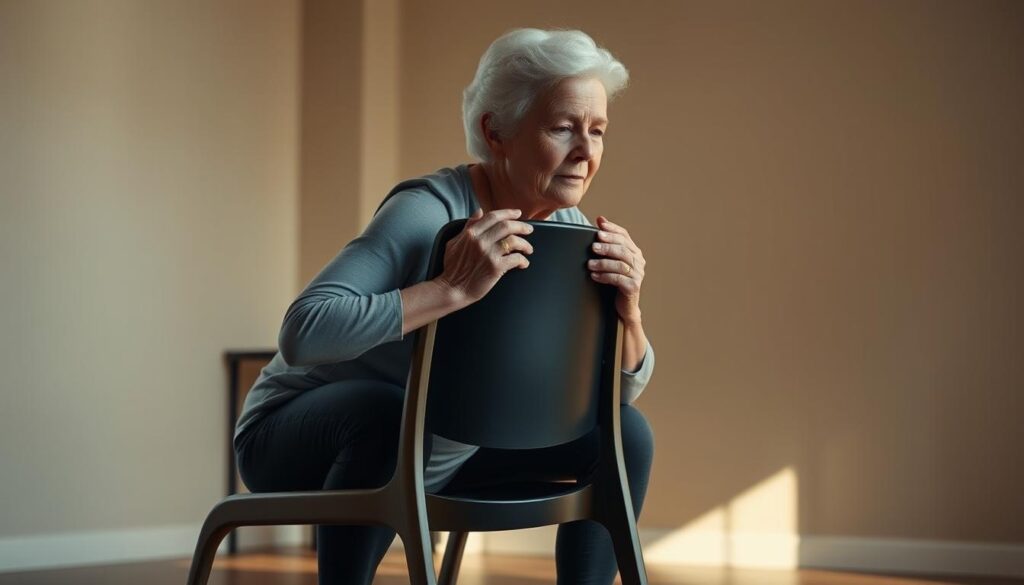
Let’s face it—fitness isn’t one-size-fits-all, especially when you’re starting out. The beauty of movement? You can tweak it like your grandma’s famous chili recipe. My client Bert, 70, puts it best: “I’m not trying to win races—just outlast my grandpuppy at the park.”
Modified Versions for Beginners
Take the classic sit-to-stand. Beginners, grab a dining chair instead of a low sofa. Why? Higher seats reduce strain on knees by 40%, per Hinge Health studies. Focus on pressing through your heels like you’re squishing grapes, not launching a rocket.
Partial squats are your new BFF. Lower just 6 inches—think “sitting onto a barstool.” Keep your chest lifted like you’re balancing a cupcake on your collarbone. Pro tip: Use a wall for support if needed. One client joked, “It’s like learning to waltz with an invisible partner!”
| Exercise | Beginner Modification | Pro Tip |
|---|---|---|
| Sit-to-stand | Use chair with arms | Whisper “heels down” as you rise |
| Calf raises | Hold counter with one hand | Pretend you’re tip-toeing over hot sand |
| Knee extensions | Add pillow under thighs | Imagine pushing through peanut butter |
Timing matters more than reps. When lowering into a chair, count “one-potato-two” out loud. This simple trick builds control faster than a toddler stacking blocks. And always? Keep your chest forward—it prevents that awkward turtle-on-its-back feeling.
Remember: Starting small builds big wins. As Bert says, “Even snowmen start with one flake!” Your heels, chest, and patience will thank you later.
Wrapping Up Your Routine for Ongoing Mobility
Your body’s roadmap isn’t static—it’s got detours and scenic routes. Those sit stand exercise drills? They’re like oiling a creaky gate hinge. My client Margo, 71, calls them her “morning coffee ritual” because they make everything else flow smoother.
Here’s the kicker: Your best leg strengthening strategy isn’t a checklist—it’s a conversation. Swap moves when your knees whisper “enough” or add pauses during extension drills. Physical therapists live for these micro-adjustments. One told me, “Progress hides in the tweaks, not the trophies.”
Six months into my own routine, I noticed something wild—bending to tie shoes felt less like wrestling a sleeping bag. That’s the magic of leg strengthening exercise consistency. Not perfection. Not heroics. Just showing up.
So keep tinkering. Try balancing on a folded towel during calf raises. Turn sit stand exercise reps into a dance with your recliner. Your mobility journey’s got no finish line—just new horizons to explore, one sturdy step at a time.
